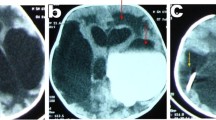Abstract
Neuroendoscopic surgery was used to treat patients with various forms of hydrocephalus with specific pathophysiology, including long-standing overt ventriculomegaly in adulthood (LOVA), isolated unilateral hydrocephalus (IUH), isolated IV ventricle (IFV), disproportionately large IV ventricle (DLFV), isolated rhombencephalic ventricle (IRV), isolated quarto-ventriculomegaly (IQV), dorsal sac in holoprosencephaly (DS), and loculated ventricle (LV). A total of 26 operative procedures were performed, with neuroendoscopic surgery in 22 patients, 12 with unique forms of noncommunicating hydrocephalus and 10 with various types of postshunt isolated compartment. These procedures included III ventriculostomy, aqueductal plasty by both rostral and caudal approaches, foraminal plasty in the foramen of Monro/foramen of Magendie, septostomy, IV ventriculostomy, fenestration of septation in the loculated ventricle, fenestration of arachnoid cyst or cystic tumor obstructing a ventricle with or without tumor removal, and dorsal sac ventriculostomy. The characteristics of the cerebrospinal fluid (CSF) dynamics in the individual specific pathophysiologies were delineated by cardiac-gated cine-mode magnetic resonance imaging (MRI) before and after the endoscopic procedure. The consequent success rate (success = restoration of communication of the CSF pathway in the individual patients) was 19/22 (86.4%). The progression of ventricular dilatation was stopped in 17 of 19 patients (89.5%) in whom the endoscopic procedure was successful (radiologically arrested hydrocephalus). Improvement in the clinical symptoms and signs (clinically arrested hydrocephalus) was obtained in 15 of the patients (68.2% of all patients: 5 with LOVA, 3 with IQV, 5 with IUH and 2 with LV). Seven patients (2 LOVA, 2 IFV, 1 DS, 1 DFLV and 1 IRV) underwent a shunt procedure after the neuroendoscopic procedure(s). The postoperative changes of ventriculomegaly were complicated, reflecting the differences in the brain parenchymal compliance and postoperatively corrected CSF flow dynamics in the major CSF pathway.
Similar content being viewed by others
Author information
Authors and Affiliations
Additional information
Received: 5 September 1998
Rights and permissions
About this article
Cite this article
Oi, S., Hidaka, M., Honda, Y. et al. Neuroendoscopic surgery for specific forms of hydrocephalus. Child's Nerv Syst 15, 56–68 (1999). https://doi.org/10.1007/s003810050330
Issue Date:
DOI: https://doi.org/10.1007/s003810050330




